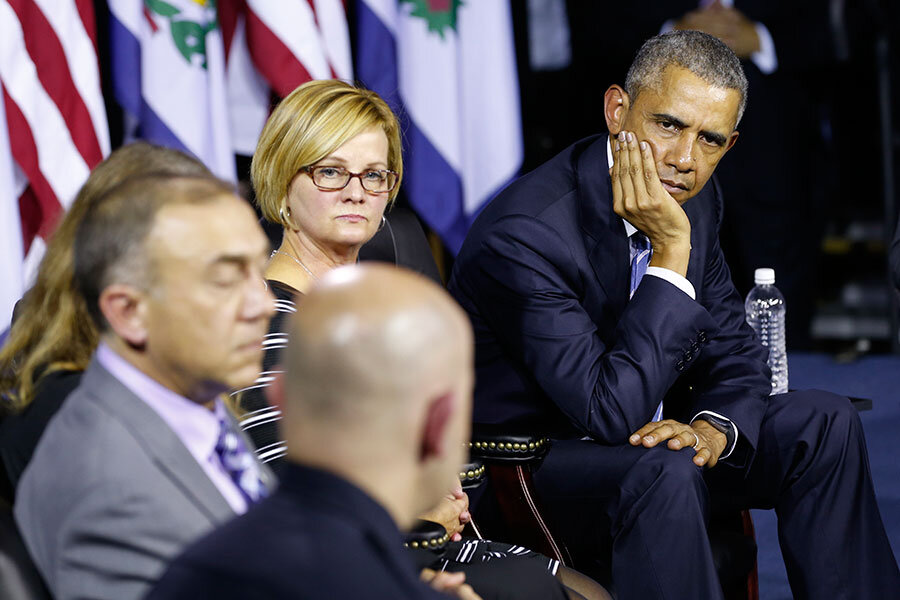Behind Obama's heroin plan, a shift in how America sees addicts
Loading...
| Nashua, N.H.
President Obama’s announcement Wednesday of a new plan to rein in heroin use is part of a broader shift toward looking to help addicts rather than punish them, substance abuse experts say.
The thrust of the plan is to improve prevention efforts and access to treatment for the estimated 2 million Americans addicted to prescription drugs or heroin. Some 80 percent face barriers to treatment, the American Society of Addiction Medicine reports.
Mr. Obama wants to accomplish this by boosting training for physicians who prescribe opioids, a type of pain medication that the vast majority of heroin addicts misuse before turning to heroin. State and local governments, as well as the private sector, will also double the number of physicians certified to prescribe drugs to treat those addicted to opioids and heroin.
“What’s most helpful is that now there’s a shift … to identifying solutions,” says Linda Saunders Paquette, executive director of New Futures, a nonprofit group working to reduce drug and alcohol problems in New Hampshire. “To have the president come up with a multipronged approach to addressing the opiate epidemic is extremely important.”
Obama's steps are relatively modest efforts, given the budget stalemate in Congress. The White House has proposed $133 million for new treatment programs. The administration has said it wants to expand access to medications that can help addicts transition off other opioids, and has also pushed to expand availability of naloxone, a drug that can reverse overdoses.
Like many states, New Hampshire has seen a dramatic rise in heroin overdoses in recent years. The Granite State ranked third in the nation for extended-release opioid prescriptions in a 2014 report by the Centers for Disease Control. It was one of the last states to establish a prescription monitoring system to try to cut down on people hopping from doctor to doctor to feed their addictions.
“We know that there is a need for education for prescribers around opiates and appropriate levels of dosing … and we are working to ensure that people who are in need of treatment are able to access it,” Ms. Paquette says.
To help prevent opioid addictions, Mr. Obama directed federal agencies to ensure there is prescriber training for federal health care providers, and announced that 40 provider groups around the country have committed to such training for 540,000 health care providers in the next two years.
In New Hampshire, the first of several regional prescriber training sessions is already set for Nov. 13. It will cover topics such as assessing the risk of opioid misuse, counseling patients about safety, and monitoring patients effectively.
Meanwhile, to help those already battling with addictions, Obama directed federal agencies to review what barriers exist to access to treatments by medication and, within 90 days, to submit an action plan to address them.
Over the next three years, the number of physicians certified to prescribe buprenorphine for those with opioid-use disorders will also rise from 30,000 to 60,000, Obama announced.
That’s “outstanding, but if it’s another 30,000 like the ones we have now, we’re not going to get the results we want,” says Jeff DeFlavio, founder of Recover Together, which offers medication-assisted treatment integrated with group therapy in New Hampshire and Maine.
He’s not faulting the doctors but says the system doesn’t provide enough training or reimbursement to equip many of them to effectively treat opioid and heroin addiction, particularly in rural areas.
Currently, doctors certified to prescribe buprenorphene tend to do so in individual appointments with patients, but group therapy has a better success rate, because people need a support system as they work toward recovery, Mr. DeFlavio says. Reimbursement rates for group therapy are dismally low, he adds.
Recover Together has a 60 percent retention rate in treatment after six months, compared with typically less than 25 percent for individual appointments, DeFlavio says. His clinics charge patients $65 per week.
Many doctors who already are allowed to prescribe buprenorphene don’t do so because they either don’t have enough training or they’ve already taken on cases and have become burned out by the workload, DeFlavio says.
“It’s so frustrating, because the people on waiting lists are real people … who want to change their life … and no one will help them,” DeFlavio says.
The whole system of care needs to shift toward a team approach to get people off waiting lists, he says. If treatment is effective, people will end up getting off medication, which will open up slots for new patients.
• Associated Press material was used in this report.








